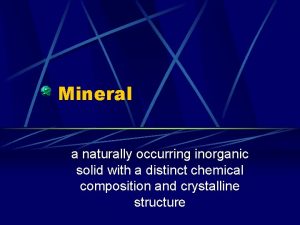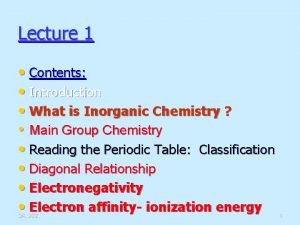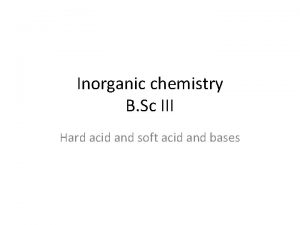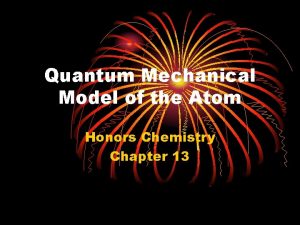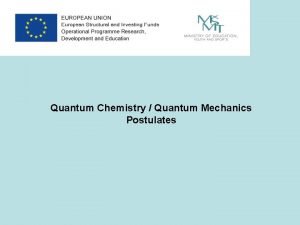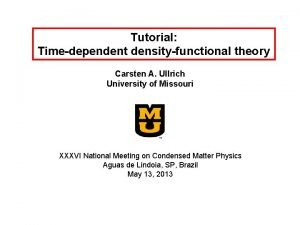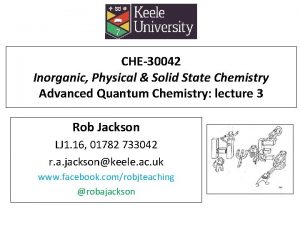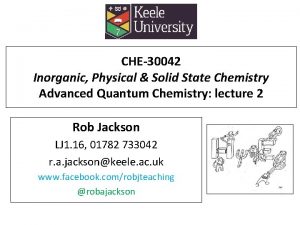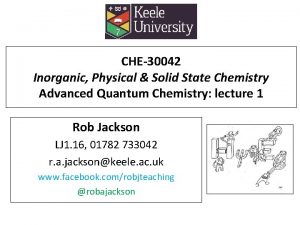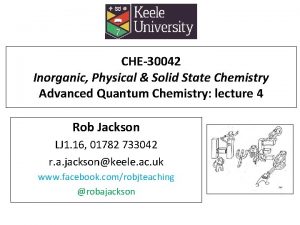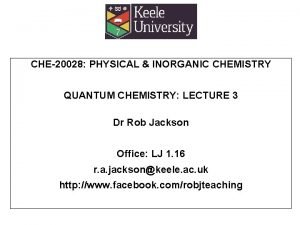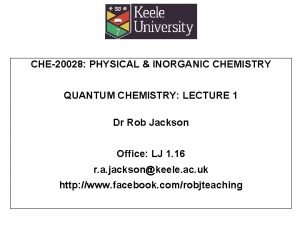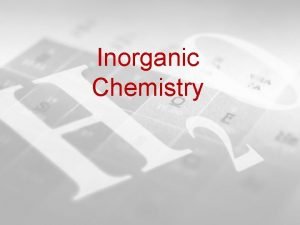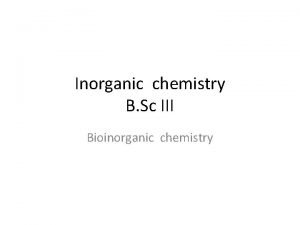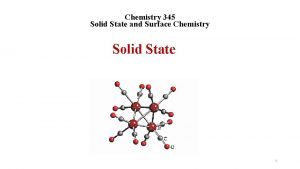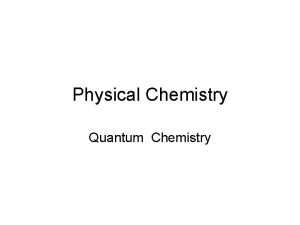CHE30042 Inorganic Physical Solid State Chemistry Advanced Quantum















- Slides: 15

CHE-30042 Inorganic, Physical & Solid State Chemistry Advanced Quantum Chemistry: lecture 5 Rob Jackson LJ 1. 16, 01782 733042 r. a. jackson@keele. ac. uk www. facebook. com/robjteaching @robajackson

Lecture 5 contents 1. An example of molecular orbital calculations: HF • Showing how MO diagrams and calculation results relate to each other. 2. Using the Gaussian program: • • • Setting up the calculation Extracting the results Comparison with Coulson’s results from 1937. che-30042 Advanced QC lecture 5 2

Illustration of the result of MO calculations on HF Details of HF MO scheme: Diagram of scheme: • The 1 s and 2 s orbitals from F are too low in energy to be involved in bonding. • The F 2 pz orbital has the right symmetry to overlap with the H 1 s orbital to form 2 orbitals, one bonding, one antibonding. The 2 px and 2 py orbitals form orbitals. che-30042 Advanced QC lecture 5 3

How are the MOs in HF written? • In lecture 4, we used expressions for the MOs: = c A A + c B B • If we carry out an SCF calculation on HF we get, for the orbitals: and ( ) = 0. 33 H, 1 s + 0. 94 F, 2 pz ( ) = 0. 94 H, 1 s + 0. 33 F, 2 pz – This shows that the bonding orbital is mainly from the F 2 pz, and the antibonding orbital is mainly from H 1 s. che-30042 Advanced QC lecture 5 4

Using the Gaussian program • Gaussian is a computer program for computational chemistry initially released in 1970 by John Pople and his research group at Carnegie-Mellon University, USA. It has been continuously updated since then. The name originates from Pople's use of Gaussian orbitals to speed up calculations compared to those using Slater-type orbitals, a choice made to improve performance considering the limited computing capacities of then available computer hardware. • We will use the Windows version of Gaussian 03, available on the PCs in the Faculty Lab. che-30042 Advanced QC lecture 5 5

What information does the program need? – (i) • Molecular geometry and Z matrices – The program needs to know the molecular geometry and this is represented by a Z matrix. For H 2 it is: H H 1 R – This means that the first atom is H, and the second is also H, bonded to atom 1 at a distance R (if you know R you can specify it). A starting value for R is specified for geometry optimisation. • Try HCl as another example. che-30042 Advanced QC lecture 5 6

What information does the program need? – (ii) • As well as the molecular geometry, the type of calculation and the basis set information needs to be specified. – e. g. for H 2, we specify # RHF STO-3 G OPT – This gives the type of calculation (RHF is a closed-shell SCF calculation), the basis set, e. g. STO-3 G (lecture 4), and the keyword ‘OPT’, which tells the program to optimise the geometry (i. e. the H 2 bond length). che-30042 Advanced QC lecture 5 7

The Gaussian dataset summarised # RHF STO-3 G OPT Hydrogen geometry optimisation 01 H H 1 R R=1. 0 Calculation type, basis set, keyword (blank line) Title (blank line) Molecule charge, state (singlet) Z matrix line 1 Z matrix line 2 (blank line) Starting value of R (in Å) che-30042 Advanced QC lecture 5 8

Extracting information from the output file (i) • In the workshop you are asked to produce a table like this: Basis set Total Energy/H Re/Å STO-3 G STO-6 G 3 -21 G 6 -31 G Experimental - che-30042 Advanced QC lecture 5 9

Extracting information from the output file (ii) • Search for the last occurrence* of the following: ‘SCF Done: E(RHF) = ‘ • Further down is confirmation that the structure is optimised: * To ensure you have the minimum value of the energy. che-30042 Advanced QC lecture 5 10

Extracting information from the output file (iii) – NB different from script! • Just below ‘Stationary point found’, it says: – The value R(1, 2) = 0. 712 is the H-H bond length in Å. – Also –DE/DX should be small (energy gradient). che-30042 Advanced QC lecture 5 11

Coulson: the first MO calculations (1937) • This paper (available from the KLE) describes Coulson’s first calculations on H 2. • Keele trivia point – he did his Ph. D with Lennard-Jones in Cambridge, who later became one of the first Principals of UCNS, which in turn became Keele. che-30042 Advanced QC lecture 5 12

Comparing results with those of Coulson • Coulson carried out one of the first MO calculations on H 2 in 1937 – Note: these calculations were probably largely done by hand! • He initially used a MO based on free atomic orbitals, 1 s. A + 1 s. B – This gives Re= 0. 850 Å, which becomes 0. 732 Å if the orbitals are scaled to account for the molecular environment. che-30042 Advanced QC lecture 5 13

Further comparison • See ‘The Gaussian Programs as a Teaching Tool: A Case Study on Molecular Hydrogen Calculations’ (copy on KLE). • It is seen that the minimal basis sets STO-3 G & STO-6 G give better results than Coulson’s free atom orbitals, but not as good as his scaled result. • This paper also shows you how to set up a calculation that closely emulates what Coulson did. Try it and see if you can get it to work! che-30042 Advanced QC lecture 5 14

Lecture summary • An example of MO calculations has been given for HF, relating MO diagrams to calculation results. • The Gaussian program has been introduced, and the procedure for running calculations and extracting results explained. • Results for molecular hydrogen have been compared with those obtained by Coulson, and the differences have been discussed. che-30042 Advanced QC lecture 5 15
 Advanced inorganic chemistry lecture notes
Advanced inorganic chemistry lecture notes Inorganic chemistry vs organic chemistry
Inorganic chemistry vs organic chemistry Naturally occurring inorganic solid
Naturally occurring inorganic solid Importance of inorganic chemistry
Importance of inorganic chemistry Organic vs inorganic molecules
Organic vs inorganic molecules Inert pair effect
Inert pair effect Fajans rule
Fajans rule Classical physics
Classical physics Quantum physics vs mechanics
Quantum physics vs mechanics Quantum mechanical model definition chemistry
Quantum mechanical model definition chemistry Quantum mechanics postulates
Quantum mechanics postulates Quantum chemistry
Quantum chemistry Crystalline or amorphous
Crystalline or amorphous Solution example
Solution example Covalent molecular and covalent network
Covalent molecular and covalent network Crystalline vs non crystalline
Crystalline vs non crystalline


